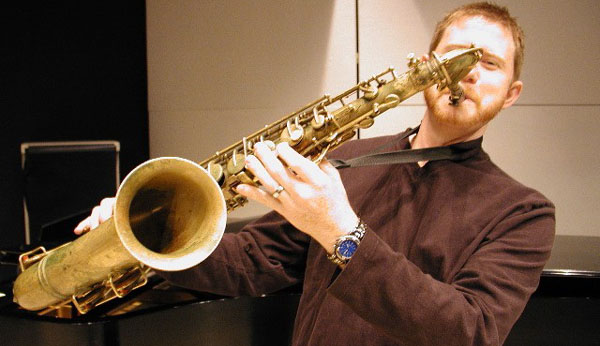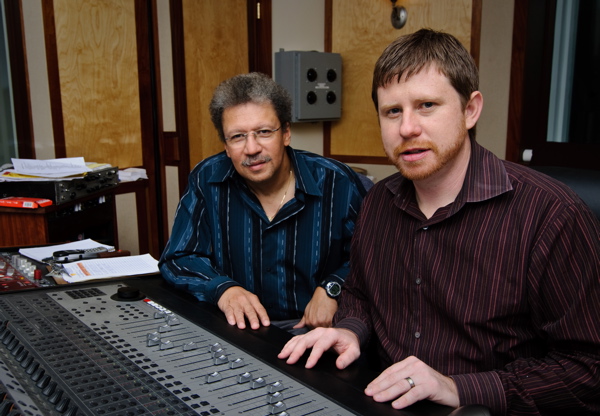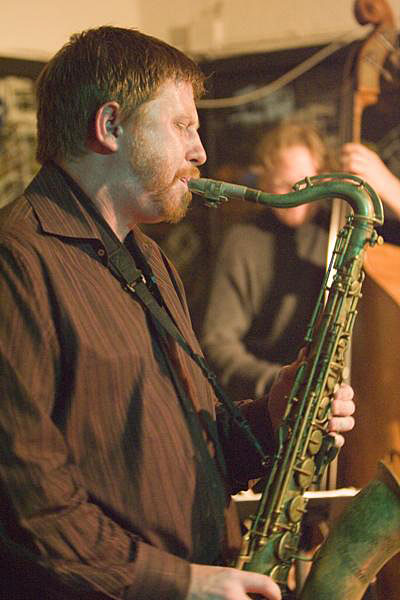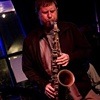Home » Jazz Articles » Interview » Jason Robinson: The New Western
Jason Robinson: The New Western

It seems like the industry prefers that you're [either] very experimental or more mainstream. And the in-between is not the normal route, even though most of us live in the in-between.
All About Jazz: Are you hot or cool?
Jason Robinson: In terms of style?
AAJ: However you want to take the question.
JR: Being from California it's a little loaded [laughs]. Being from California, in general, one of the things that has been very present is this notion of West Coast jazz, or cool jazz. I'm from northern California and I came of age musically in the San Francisco scene. The music that I was making, when younger, has more in common with hard bop of the '50s, stuff that was more associated with the East Coast. It wasn't just me; most of the musicians on the scene I was part of were more in dialogue with those kinds of things rather than cool jazz. When I was in San Francisco, it was the end of the acid jazz scene or era. The people I was playing with, we were really exploring an intersection between freestyle rap, turntablism; we had groups back then that were, for all intents and purposes, jazz groups, hard-hitting modern hard bop, but in the group we'd also have a freestyle emcee, and someone playing a turntables with us as well—taking solos.
I was also playing a lot of super-straight-ahead stuff, modern bebop. So those were two important poles for me. The cool jazz thing, it was always there, but I've run into very few musicians who were really that into it on the West Coast. It's almost like a specter. It's hard to find. On the West Coast, we're all presented with this history, whether or not it speaks to us. I was more interested in West Coasters like Buddy Collette and Horace Tapscott. And there were the equivalent of those people in the Bay Area. Those people spoke to me on a different level than cool jazz did. That and people like Charles Mingus and Dexter Gordon—they're from California. So I was aware of that history. That gives you a lot to run with.
AAJ: Archaeologically speaking you're very devoted to California and the schools there, the way they intertwined, whether it's Mingus or Dexter Gordon.
JR: Yeah, on a certain level. I'm the product of the communities I came out of, just like everybody else. Now I'm much more of a traveling Californian. There's a certain responsibility I feel towards projecting a kind of vision of what kind of jazz is happening today that is more open. Because there is a lot of amazing stuff that happens there that certainly does not make the New York-oriented jazz press. But it barely makes the press in California itself.
AAJ: Where does your energy come from?
JR: I think from just life, in general. I'm not fully from the Charlie Parker school of "live it, or it won't come out on your horn." I don't fully believe in that. I tend to draw inspiration for music just from the vicissitudes of life—being a member of different kinds of communities, American—and I also think a part of this jazz continuum is a strong responsibility to the people of the past, on a certain level. But also just the recorded history of the music. I find a lot of inspiration imagining myself as part of a continued evolution of the music. Not that I think of myself in a grand way. But the music is going to stay alive, because we're all here doing it. It's quite inspiring once you start imagining yourself as part of the same stream as other people.
 AAJ: Patricia Nicholson said, after a Charles Gayle performance at the Vision Fest this year, "Who said giants don't walk the earth anymore?" We keep thinking of each generation being smaller than the one before it, but who's to say you're not the next Joe Henderson?
AAJ: Patricia Nicholson said, after a Charles Gayle performance at the Vision Fest this year, "Who said giants don't walk the earth anymore?" We keep thinking of each generation being smaller than the one before it, but who's to say you're not the next Joe Henderson? JR: If I could play one tenth the way Joe Henderson plays I'd consider myself successful.
AAJ: Discipline, humility, respect for the past...
JR: Absolutely. The people I admire in the history of jazz had that humility in the face of tradition.
AAJ: Your music is accessible on the surface. It's not jarring or grating. You can sit back and relax to it. And then as you dig into it so can see the complexity. It doesn't shout out, "We're intellectuals," the way the great Evan Parker might.
JR: Certain experimental approaches are very important to me. But they're not—I think in the end, we're all—even Evan—just trying to make beautiful music. And beauty isn't something that always looks good or sounds good. It has to capture the ups and downs of life, the full emotional color spectrum of our lives. And I think it comes out in different ways in each of us, as musicians and as composers.
 From leftt: Anthony Davis, Jason Robinson
From leftt: Anthony Davis, Jason RobinsonOn these three albums I have released in the last month, on a nuts and bolts level, there are certain kinds of questions I am exploring. And then there are these larger, more philosophical layers. And really, in all those layers, I'm just trying to make good music, music that speaks to me and hopefully to others. I'm not trying to take a confrontational stance like, "Come listen to this great music!" I want to invite people in. I don't change the music for that; there isn't any sense of "watering down," that never enters into the process. I think there are a lot of us who live in the border between extreme experimentalism and, for lack of a better term, the mainstream. It's a challenging place to be, because it seems like the industry (whatever that is, as there's not much of a jazz industry left) prefers that you're [either] very experimental, in a certain sense, or more mainstream. And the in-between is not the normal route, even though most of us live in the in-between. So I'm glad you hear that in the music.
AAJ: Are you seeking a wider audience, maybe a younger one than Evan Parker would seek?
JR: Maybe so. In a perfect world my music would speak across generational lines and gender lines and all the other kinds of fault lines across our society. But I'm not necessarily purposefully seeking out doing things to the music so it might speak to a different generation.
AAJ: Do find your music appeals to women?
JR: That's a tricky question, because most of us do our best not to put up barriers. There's always a lot of debate about jazz culture in general, whether or not it might be masculine to the point where it's exclusionary. I certainly don't want to replicate any of that kind of exclusionary politics that might have been in place in the past, or still to this day. And I think that things hopefully are starting to change. We generally have the conception that there are less female musicians in jazz. And my sense is that, if we look more closely at the history and at contemporary communities, there's actually more women participating than the mainstream narratives might suggest.
And in the past, we can write a history of jazz that looks more closely at women contributors. We might go back to someone like Lil Hardin Armstrong, and see that in many ways she was a kind of musical genius. She was in King Oliver's Creole Jazz Band when Louis Armstrong joined it. In some of Louis' Hot Fives and Sevens, she was like the de facto bandleader, and they played a lot of her tunes. This is a very long way of saying; I just hope my music isn't exclusionary.
AAJ: Off the cuff you make me think of Gato Barbieri, Arthur Blythe—and then the John Coltrane of Ballads (Impulse!, 1963), the way you mix the hot and cool; the complex with the mellow polish.
JR: Certainly Coltrane has been a central point of reference for me over the years.
AAJ: I notice that you'll introduce him very discretely. In a solo of yours, for example, I might hear a certain squeak and say, "That's Coltrane."
 JR: Coltrane's been an enduring influence on many levels. Sometimes it doesn't come out and sometimes it comes out more. My background is really [as a ] post-bop saxophonist. That was my initial entry into the music, and then it expanded. My interest really broadened at a certain point. So, Arthur Blythe for example has been very important. Gato, a little less so. AAJ: I see facets and sparkles of many artists in your playing, like Toots & Maytals. Did they seek you or did you seek them?
JR: Coltrane's been an enduring influence on many levels. Sometimes it doesn't come out and sometimes it comes out more. My background is really [as a ] post-bop saxophonist. That was my initial entry into the music, and then it expanded. My interest really broadened at a certain point. So, Arthur Blythe for example has been very important. Gato, a little less so. AAJ: I see facets and sparkles of many artists in your playing, like Toots & Maytals. Did they seek you or did you seek them? JR: They sought me. A short long story: right before I left the Bay Area some of my college buddies formed what is now a quite well known roots reggae band called Groundation. They invited me to play with them and I've been with them since 1998. In their music, one of the things that kept me playing with them is that they're largely based in the gnarly, Israel Vibration mid-1970s roots reggae language, but they've really done this really interesting job merging with the improvisatory sensibilities of jazz musicians. And because of that they're often marked as different from their Jamaican counterparts. Extended dub sections that are improvised on stage. Parts of songs are completely unscripted improvisation, with groove and everything. We all thrive on that.
 That got me hooked on playing in certain contexts in reggae. So, in San Francisco, I started playing with Elijah —a stage name. It has biblical references. He had a group called Elijah Emanuel and The Revelations. Through that we became connected with certain people involved in the international reggae scene. It was essentially Elijah's horn section that was asked to record with Toots. Toots is amazing. He's the world's most energetic grandfather.
That got me hooked on playing in certain contexts in reggae. So, in San Francisco, I started playing with Elijah —a stage name. It has biblical references. He had a group called Elijah Emanuel and The Revelations. Through that we became connected with certain people involved in the international reggae scene. It was essentially Elijah's horn section that was asked to record with Toots. Toots is amazing. He's the world's most energetic grandfather. AAJ: Was it hard to adapt to the reggae, or did you find you could just do your thing and cut loose?
JR: There are definitely a certain kind of rhythmic parameters in any groove based music. Rhythmic relationships are these grids. And depending what type of music you're playing, dance reggae or even roots reggae, it can be very nuanced. There's a tour I did with Groundation, with drummer Horesmouth Wallace. He came into the band for this one tour, and he introduced us to this whole vocabulary of the different nuances of grooves. There's rockers, there's steppers—all these different types of grooves. For me it was very fulfilling to learn this stuff and make it work in the jazz sense.
So I was coming from that perspective, of "How do you create these other soundscapes?" And I still do that when I play reggae. Sure, I'm approaching it with the sensibility of someone who has thought about harmony and melody and improvisation from a jazz perspective. But every context is unique. I'm just trying to make a new statement in different contexts.
AAJ: You walk a tightrope between your music and your scholarship. Is it hard to stay creative?
JR: I look at the academic work that I do, and the writing and publishing and theorizing as just another dimension of my creative work. In other words I tend to not really draw the distinction between playing and theorizing. This identity of the artist/scholar is becoming more prevalent—Anthony Braxton, and I studied with George Lewis, the trombonist. There are other types, too, like Horace Tapscott. He wasn't necessarily doing scholarship, but he was doing community activism which was totally interrelated to his music making. So there are these other kinds of models of what it means to be a musician out there that might go beyond just playing the music. It was sort of a natural thing for me.
When I was an undergraduate at Sonoma State University I ended up becoming a philosophy double major. The reason why I was drawn to that was I was able to look at certain music questions in a different way. I couldn't pose those questions in a music department, because they were too esoteric—or just outside of what the curriculum was. Does it make sense to discuss the aesthetics of improvisation drawing on Heidegger, or Wittgenstein—when you're in a jazz improvisation class? They're just like different worlds. And I'd like to see those two worlds a little more intertwined. And I think they are. Coltane's fascination with religion is just one way in which music making and theorizing and thinking are intertwined. There's been this false dichotomy created that says, if you're a performer, a musician, you can't do the theorizing. Or if you do the theorizing you're not a legitimate musician. Time management is a tricky thing but I find my life is most fulfilling when I'm able to do both at the same time—working on new ideas, new kinds of scholarship while I'm working on new musical ideas...On a philosophical level improvisation is one mode in which I create who I am—and recreate and revise and signify. So it's all interrelated.
 AAJ: How about theory on a technical level—things like chord structure?
AAJ: How about theory on a technical level—things like chord structure? JR: Absolutely. There are always certain technical questions that are fueling musical exploration for me, new kinds of composing, new kinds of improvising. But at the same time there tends to be these philosophic questions as well. But they work together. On most of my projects, I'm thinking on those two levels.
AAJ: You have different narratives. Fred Frith said that every time a musician improvises, they recapitulate their whole life up to that point. There's also the narrative of the history of the music, in addition resolving technical theory. How do you negotiate among all these narratives?
JR: When we play now, we embody a big, broad, vast history. I can't imagine myself without thinking about Coltrane or these other people we've been talking about, these historical figures. If I don't talk about them I think I'm not doing justice to the spirit of the music. We have to acknowledge these ancestors. And we do embody their histories to a certain degree. We're caught up in different politics that say who can claim certain histories. And usually people are policing those boundaries for one reason or another. In my opinion, we have to give respect where respect is due...We do really embody these people's history. We have to acknowledge our predecessors, or else we forget where we came from.
Selected Discography
Jason Robinson, The Two Faces of Janus (Cuneiform, 2010)
Jason Robinson/Anthony Davis, Cerulean Landscape (Clean Feed, 2010)
Jason Robinson, Cerberus Reigning (Accretions, 2010)
Jason Robinson, Cerberus Rising (Circumvention, 2009)
Cosmologic, Eyes in the Back of My Head (Cuneiform, 2008)
Jason Robinson, Fingerprint (Circumvention, 2008)
Cross Border Trio, New Directions (Circumvention, 2007)
Cosmologic, III (Circumvention, 2005)
Hans Fjellestad/Peter Kowald/Dana Reason/Jason Robinson, Dual Resonance (Circumvention, 2003)
Jason Robinson, Tandem (Accretions, 2002)
Cosmologic, Syntaxis (Circumvention, 2002)
Cosmologic, Staring at the Sun (Circumvention, 2000)
Jason Robinson, From the Sun (Circumvention, 1998)
Photo Credits
Page 1: John Rogers, Courtesy of Jason Robinson
Page 2: Charles Quigg, Courtesy of Jason Robinson
Page 3: Courtesy of Jason Robinson
< Previous
The Two Faces of Janus
Comments
About Jason Robinson
Instrument: Saxophone, tenor
Related Articles | Concerts | Albums | Photos | Similar ToTags
Jason Robinson
Interview
Gordon Marshall
United States
Buddy Collette
Horace Tapscott
Charles Mingus
Dexter Gordon
Charlie Parker
Charles Gayle
Joe Henderson
evan parker
Lil Hardin Armstrong
King Oliver
Louis Armstrong
Gato Barbieri
Arthur Blythe
John Coltrane
Toots and the Maytals
anthony braxton
George Lewis
Fred Frith
For the Love of Jazz
 All About Jazz has been a pillar of jazz since 1995, championing it as an art form and, more importantly, supporting the musicians who create it. Our enduring commitment has made "AAJ" one of the most culturally important websites of its kind, read by hundreds of thousands of fans, musicians and industry figures every month.
All About Jazz has been a pillar of jazz since 1995, championing it as an art form and, more importantly, supporting the musicians who create it. Our enduring commitment has made "AAJ" one of the most culturally important websites of its kind, read by hundreds of thousands of fans, musicians and industry figures every month.






















